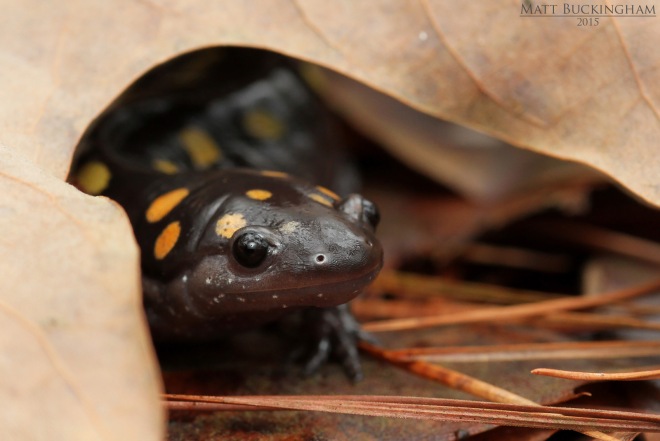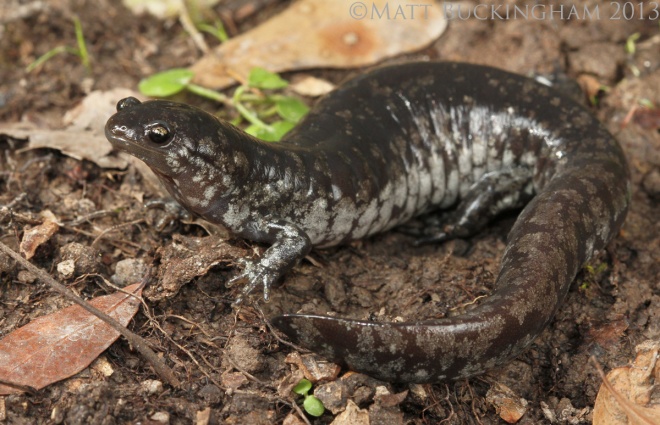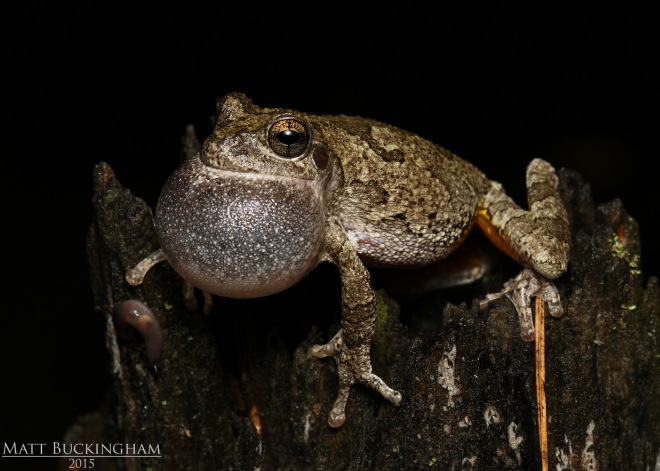
East Texas Waterfall
As I write this, on a cold and rainy day at the end of December, all but a handful of brave trees have cast their leaves in preparation for the darkness and cold that winter brings. Days like this it’s easy to long for the milder days and brilliant colors of fall. This year was a particularly beautiful autumn in the Pineywoods, with many species putting on displays of color that I had not seen for some time. To fight off the gloom of this winter’s day, I decided to live vicariously through my memories as I chronicle my autumn explorations here.
We’ll start on my birthday. At the start of October, the days have become shorter and the temperatures begin to cool. October has always been one of my favorite months here in Texas. The colors begin to turn, and the climate is mild. Cool enough that it is pleasant to be outside, yet warm enough that many winter-adverse species such as reptiles and insects are still active. A number of interesting fall-blooming plants are also on display in this month of the Hunter’s Moon.
On my birthday we set out to find a few such plants. The first that we came across was the Indian Pipe (Monotropa uniflora), also known as the Ghost or Corpse Plant. This interesting fungus-eating plant is a member of the blueberry family, of all things. It does not produce chlorophyll like most traditional plants, but rather obtains its energy and nutrients from the mycorhizzal fungi of tree roots. In Texas they may begin to bloom in late August or early September, and I have seen them as late at January (late in the sense that it is at the end of the blooming season for this species). The flowers’ superficial resemblance to a pipe as inspired stories in Native American folklore, including the idea that these plants mark the graves of old chiefs, and provide them a vessel with which to smoke from the afterlife.

Indian Pipes

Indian Pipes
Growing near the Indian Pipes, in the shade of American Beech was a rare treat, Tall Rattlesnake Root (Prenanthes altissima). Though it may line the roadsides further east, it is known from only a few isolated locations in extreme eastern Texas. Here it grows on steep hillside springheads and the banks of springfed streams in mature hardwood forests.

Tall Rattlesnake Root
Ample rains in September fueled a profusion of fungi, whose fibrous filaments draw moisture from the earth and feed on the ample detritus beneath the leaf litter. Fungi are fascinating, beautiful organisms. They lead most of their lives hidden below ground, but grace us with a spectacular display when their fruiting bodies form. Perhaps my favorites are the many varieties of coral fungus. Each is unique, and contain an intricate maze of protrusions that seem crafted by some avant-garde architect.

Coral Fungus
Many species of fungus are quite toxic to humans, but there are some that are said to be delicious. I personally have never been brave enough to try wild mushrooms. It seems like for every edible species there is a lethal, or at least debilitating look-alike. One species that is favored by foragers is the Indigo Milk Cap (Lactarius indigo) which an be found in hardwood bottoms in late summer and early fall.

Indigo Milk Cap
Fungi come in a staggering array of shapes and colors. They are also fun to photograph, and lead the mind to find interesting angles and compositions with which to present them.

Fungi (I believe these are chanterelles)

Fungi
Autumn also signals the beginning of the salamander breeding season in East Texas. In mid-October conditions were right for Marbled Salamanders (Ambystoma opacum) to make their annual breeding migrations. Unlike most members of the family Ambystomatidae, which breed in the water during late winter and early spring, the Marbled Salamander breeds on dry land, and the females lay their eggs under woody debris within dry vernal pool basins. They will then guard the eggs as they wait for winter rains to fill the pools and disperse and hatch their offspring. By doing this they get a leg up on the competition, so to speak, which comes in the form of other amphibian larvae that won’t begin to develop for another couple of months.

Marbled Salamander Male
Marbled Salamanders are one of relatively few amphibian species that are sexually dimorphic. The males (pictured above) have bright silvery white dorsal patterns while the females (pictured below) have duller silver to coppery markings. The males also display a swollen cloaca at the base of their tail during the breeding season.

Marbled Salamander
In late October Caro and I spent a damp autumn day in the woods with our friends James and Erin. It provided a chance to capture more images of interesting fungi, like these Earthstars, which look like little puff balls wearing tutus.

Earthstars
We also observed a number of insects like these seemingly affectionate Six-spotted Flower Longhorn Beetles (Strangalia sexnotata).

Six-spotted Flower Longhorn Beetles
We also found a few Rainbow Scarabs (Phanaeus vindex), a spectacular beetle that I highlighted in a previous blog post.

Rainbow Scarab
And then there were the Indian Pipes. We found hundreds in a remnant Longleaf Pine savannah, pushing up through the dense carpet of needles and cones. It became somewhat of a game seeing who could spot the most. Per usual, Caro won by a landslide.
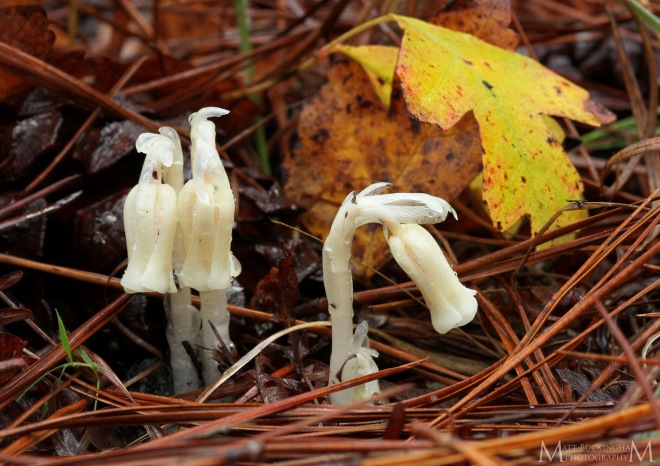
Indian Pipes
One October day I received a call from my wife that she had found a recently hit Gray Fox next to the road. Being eccentric biologist types, we decided that we wanted to try to get its skeleton for study and admiration. So we called James and Erin, who own a large tract of land, and asked if we could set it out there to decompose. Being a couple of biologists themselves, they gladly agreed and we loaded the fox carcass in the bed of my truck and set out on the half-hour or so journey to their farm.
Just after we arrived, I heard my wife call out, “Look at this!” No surprise really, as she has an uncanny talent for spotting creatures, plants, and any other thing that remains invisible to most. She had found a large adult female Carolina Mantis (Stagmomantis carolina), hiding among the goldenrod blooms near the Childress cabin.

Carolina Mantis
Of course, in our haste to make our morbid delivery I had forgotten my camera. Fortunately James was kind enough to lend me his. We approached the scene and I tried to formulate a plan on how to best photograph this spectacular insect. As we drew near we noticed the carcasses of Common Eastern Bumblebees (Bombus impatiens) scattered about the ground, dismembered and drained of their juices. Oblivious to the danger, there were several more bees nectaring on the goldenrod just inches from the mantis. So I found a good angle and waited to see if I might capture some action. I set the lens on a bee that was slowly creeping closer and closer to this devourer of pollinators. The bee brushed against the mantis’s leg, yet still the predator remained still. Its head slowly cocked and it’s antennae twitched ever so slightly. Deliberately and methodically it crept toward the ravenous bumble bee. Its movements were almost imperceptible. I captured the image below as it zeroed in on the bee and prepared its strike.
Seconds after I captured this image the mantis did strike, though I only managed to record a blur of green. It missed, and the bee flew to a distant part of the same plant to continue feeding. Later we would see the mantis in the middle of devouring another unfortunate Bombus impatiens, though we missed the strike. In all it would seem that this ruthless hunter his doing quite well on the goldenrod she has staked claim to. She remained on that withering goldenrod well into December.

Seconds from Disaster
A few days before Halloween, Caro and I set out to look for signs of fall along backroads and deep in the forest. Colors were beginning to change, with vines like Virginia Creeper and Poison Ivy putting on a brilliant display. Elms, hickories, and even some red maples were beginning to lose their chlorophyll while baldcypress was nearing peak color. Monarchs are passing through en masse, and were joined at fall blooming plants by Gulf Fritillaries, Buckeyes, and American Ladies.
In the late afternoon we came across a stunning Canebrake Rattlesnake (Crotalus horridus) taking in the Sun’s fading warmth. It was one of the lightest snakes I’ve seen, with narrow bands of almost pure white along its chevrons. I would put it at a bit under three feet in length, a decent size. And like most of its kind that I’ve encountered it rattled only briefly, and was incredible docile and non-aggressive throughout our interaction.

Canebrake Rattlesnake
After spending some time with this spectacular denizen of the deep woods, we were able to turn up a couple of Marbled Salamanders and Southern Leopard Frogs adjacent to a series of ephemeral wetlands. I then noticed a large fallen tree, its branches arching above the forest floor. While admiring the verdance of the mosses and Resurrection Fern coating the bark, I glimpsed an unusual creature swaying back and forth. It was a huge Megarhyssa atrata (a type of giant ichneumon) busy probing the chambers of horntail wasp larvae with her ovipositor. She lays her eggs in the soft flesh of these larvae, where they will hatch and consume their host as they develop. This downed tree was literally swarming with Megarhyssa atrata and M. macrurus. Though they may be “creepy” looking, these large insects are harmless and fascinating.

Megarhyssa atrata
In early November we set out to look for Long-lipped Ladies’ Tresses (Spiranthes longilabris) a rare orchid of fire-maintained Longleaf Pine Savannahs. A species of the coastal plain, they reach the western extent of their range in East Texas. Uncommon to rare throughout their range, in Texas they are known from only a handful of sites in the Big Thicket.

Long-lipped Ladies’ Tresses
Another East Texas rarity is the Kidney-leaved Grass-of-Parnassus (Parnassia asarifolia). To my knowledge, they only persist along a single drainage in the Pineywoods.

Kidney-leaved Grass-of-Parnassus
A favorite past time of Carolina and me is wandering around Ellen Trout Park here in Lufkin. There are usually a variety of interesting things to be seen, including several resident Great Egrets (Ardea alba).

Great Egret
The star attraction of the park, however, is a pair of Bald Eagles (Haliaeetus leucocephalus) that nest there each year. It wasn’t so long ago that Bald Eagles were nearing extinction, but a variety of factors including the banning of DDT and Federal regulations like the Endangered Species Act and Bald and Golden Eagle Protection Act brought them back from the brink.
While most of East Texas’s species suffered greatly from the construction of large reservoirs, this is one of a few species that has actually benefited. The damming of the major rivers of the region created tens of thousands of acres of suitable habitat for the large raptors. In East Texas, Bald Eagles prefer to nest near the top of large pine trees adjacent to large water bodies. I composed the image below to capture the essence of this habitat.

Bald Eagle
By late November, fall color had begun arriving in earnest. One one of our frequent evening drives, I spotted the stereotypical Pineywoods scene below along the backroads.

Florida Maple (Acer floridanum) generally displays a brilliant golden yellow during autumn. This year they put on quite a show on slopes and along riverbanks.

Florida Maples
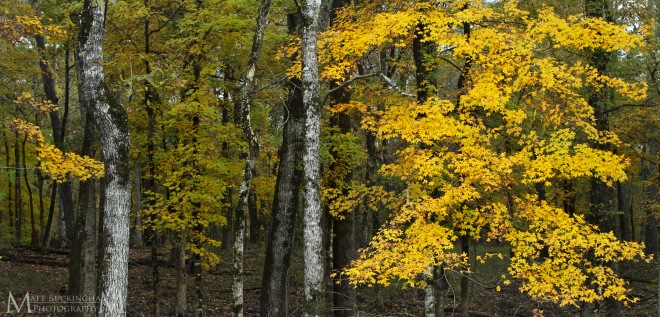
Florida Maples
In some areas Florida Maples can be found growing alongside Red Maples (Acer rubrum). In the fall, Red Maple comes in a variety of colors, including yellow, orange, and red. In the image below it held up to its namesake, and provided an excellent contrast to the bright yellows of the Florida Maple next door.

A Meeting of Maples
The Pineywoods of East Texas are known for their towering forests. While breathtaking in their own right, the abundance of trees blocks the horizon, and there are not many places in East Texas that offer broad views of the landscape. There are a few exceptions on high ridges, however, like this spot east of Nacogdoches. Here the crowns of pines and a diversity of hardwoods creates a beautiful fall palette of greens, oranges, and yellows.

Bird’s Eye View
Many species of butterfly remain active well into the fall. One of the most common is the Gulf Fritillary (Agraulis vanillae). We often see them nectaring alongside other species on fall blooming wildflowers like these asters.

Gulf Fritillary
In late November, Carolina and I made our way north to explore the forests of Cherokee and Smith Counties. Here we found countless beautiful scenes, of which I attempted to capture just a small fraction of their brilliance with the images below.

Dressed in Gold

Autumn Exposure
During this day trip, we visited Tyler State Park for the first time. The State Park system of Texas protects a multitude of important and interesting natural and cultural features. The park was beautiful, with ample fall color among mature mixed pine-hardwood forests and infrastructure created by the Civilian Conservation Corps.
I generally avoid including man-made elements in my images, however the road through the state park seemed to be asking to be photographed. I captured the image to remind me of one of my favorite past times – driving quiet back roads in fall…

The Road to Autumn
…and hiking in the autumnal forest. If you look closely in the image below you can see a hiker’s footbridge beneath Flowering Dogwoods with foliage aflame.

Tyler State Park Trail
The color of the day was definitely orange, a deviation from the standard yellows and occasional reds typical further south. The Red Maples in particular were glowing. We enjoyed our time in the park, and will likely be making a repeat visit soon!

Autumn’s Orange

Maples in the Midstory
Some autumn scenes display a more subtle beauty. I captured the scene below in the floodplain of the Neches River. The Inland Sea Oats blanketing the ground had turned brown. The bark of Sugarberries added contrast while the fall foliage of distant elms added a splash of color.

All that Remains
Perhaps the most spectacular fall scene would not reveal itself until December, when I went to visit a waterfall recently discovered by my friend Scott. This waterfall is hidden deep forest in an area where steep ravines funnel water, whose power carves shallow canyons into the erodible mudstone of the Wilcox Formation. The slopes that grade down to this stream are decorated with the golden autumn foliage of American Beech and likely harbor a vernal flora rich in peripheral species of the great Eastern deciduous forests.

There are few things that bring me more joy than a walk in the autumn woods, and though the season has turned, it’s hard to fret too much. Winter resident birds have arrived and salamanders have begun to breed. Though winter may seem the bleakest of seasons, there is lots of life for those willing to look. So for now, I will look forward to the winter and spring, and say, “until next time, autumn!”





